Our story
In this chapter
A man's world, a mother's tongue
Shall this project ever be finished?
The bold inherit history
Yes, we have legends
Toward the very beginnings
Coping with a fickle web
And other conundrums
Various religious convictions
Our friendly Wikipedia
About roots, trunk, branches, twigs
Those funny purple numbers
Our story is your story too!
Bibliography
Temper of the times
Footnotes
|
|
"There are two lasting bequests we can give our children. Edited: January 24, 2015 Composing this social history stems from a wish to get a little closer to the people whose names make up our family tree. Is it not the interactions among real people, whatever their status in society, that have done so much to shape who we ourselves are—what and how we think, what we feel, what we believe in, what we will stand for, what we abhor, and, ultimately, what we do. 3 Family trees, in western society, are traditionally strongly slanted toward the paternal side of our ancestries, the side of the family names. Nevertheless, it ought to be of some interest to reflect on the extent the formation of any individual owes to a mother. Take language, for example. Don't we speak of the "mother tongue" and doesn't mother tongue play a big role in human emotions as, for example, is currently experienced in Belgium and in Canada's province of Québec? Early childhood upbringing, along with language, is traditionally mostly left to mothers. One may wonder, therefore, why a typical genealogy follows paternal lines more than the maternal ones. When one says something like, "My family goes back to the xth century," it is pretty well understood that he/she speaks of a trail marked by the family name. Perhaps this is because of our perception that mostly it is the males who have determined the ascends and descends of any family's fortunes and status; it has mostly been the males who have carved out a living for themselves and those around them, or whose failures to cope led their families into the lower strata of society. But going into this a little deeper, it has been since times immemorial that the basic units of patriarchal, patrilinear and patrilocal extended families have been deeply ingrained in Indo-European myth and customs and law.* It is only following a deeply ingrained custom then that the principal threads through this story are sequences of fathers and sons. 4 On that branch of our family tree that interests this writer most we have a father, Adriaan (1896–1965) and his three daughters whose names have been officially recorded as Märchelbach even though they themselves never deviated from using the name Märckelbach. Adriaan inherited from his parents a printing and publishing business named De Wed. G.M. Märckelbach N.V. (with an Umlaut) which, as we shall see, is rare. Although this branch no longer supports the family name, it most certainly is continuing to grow: Adriaan now has three great-grandsons whose family names are Van Eyken, De Jong, and Mellon. He also has a great-granddaughter who married a Favreau. Those who carry on under the old family name, evidently, are not the end-all and be-all. I am probably well justified to name the 14th-century Flemish artists Jan and Hubert van Eijck as other examples. 5 This story intends to be a social history wrapped around the Merckelbachs and their paternal ancestors, the Van Anstels and Von Ballenstedts. This, of course, cannot be dissociated from the social history of the communities they belonged to, and that, in turn, is much determined by circumstances beyond personal and family horizons. A family's history is, within our genetic inheritance, very much molded by beliefs, habits, and effects of circumstances; we shall, therefore, not fail to keep looking for why we are the way we are. It is this very process, this writer's discovering of facts and insights to him unknown before, that make it necessary to continually upgrade not only the content of this project but also the form in which it is cast for it is an venerable truism that form follows function. 6 This approach is not without problems. One is that changes in the text may be disconcerting to the reader. The other is that the work yet to be done is continually expanding. Having recently turned 87 years of age (in September 2014), I am deeply concerned about my ability to bring this project, if not to some sort of completion, at least to some satisfactory state that will make it easy for someone else to continue working on it. I don't even know who that someone else might be. All I can realistically hope to achieve is laying a satisfactory foundation of sorts—for the genealogy, for the story, for the manner this work is being designed. And most of all for what may be learned from it, which is a great deal! 6A 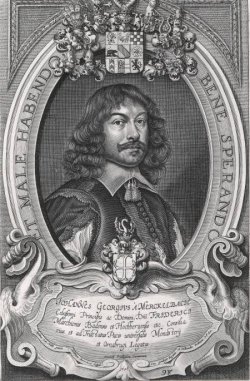
Johann Georg Von Merckelbach is among those who signed the Peace Treaty of Münster in 1648 that, among other matters, recognized the independence from Spain (or, more accuarately, from the Habsburg dynasty) of the The United Provinces. (Source.) 7 Our story begins at the time the first person in our lineage became identified as a Merckelbach. That was in the 14th century, in the high Middle Ages. It was at a time that the feudal system determined a man's place in the scheme of things. It was also at a time that rebellion against it began to transform society. This transformation progressed over the next three centuries to a point that the Low Countries, a federation of former fiefdoms, gave rise to a republic, the United Provinces (now, approximately, The Netherlands). This republic became formally recognized by surrounding powers with the signing, in 1648, of the Peace Treaty of Münster. Among the signatures on that document is found the name Johannes Georgius Merckelbach, who was the representative of, and an advisor to Frederic V, the marquis of Baden and Hochbergen. We shall get to know this Merckelbach a little better later in the story. 8 Focusing on especially meritorious ancestors, however, is averting one's gaze from the many plain folk that populate the increasingly vast family tree. It seems to me that a good social history ought to resist such a tendency. Obviously, with so much more information available about those who have done well than about those who lagged behind, we can hardly avoid this family history to be slanted, much slanted. Nevertheless, many a member of the Merckelbach family has spent a life in the lower strata of society, and through them we may gain some insight into what, throughout the ages, it has meant to be poor and downtrodden. Chapter 4 begins to get into that. 9 What better for a family history than to have a wonderful legend or two to tap into. The Merckelbach family is fortunate to have some too. One legend points to a forefather named Huyn, as in the name Vaes Huyn van Amstenrode, father of the first Merckelbach. A young Hun ingratiated himself with Charlemagne and gained the fruits of a nice property as a result. And then there is the story of a skeleton guarding three chests choc full of golden treasure in the dungeon of a castle that may well have been the birthplace of the aforenamed Johann George Von Merckelbach. These stories are told in Chapters 6 and 7. 10 Thanks to websites maintained by two tenacious researchers, Charles Cawley and Ger de Vries, we can now trace the patrilineal genealogy back much further, down to the ninth century. Those forefathers were nobles known as Von Ballenstedt and Van Anstel. It is highly unlikely we would have come across them had they lived their lives as ordinary people. 11 The fourth and fifth parts of our story, Parents of our soul and Deep roots, dig really deep down, to well before medieval times in the hope to strengthen our understanding of what made those very early ancestors tick and how that influenced the mindsets of generations to come. But eventually we shall climb the ladder of time back up again, through the birthing pangs of France, Germany, and the Low Countries. It takes us through the strife for betterment of the masses and the role Christianity played in it, through a pestilence that has cut western Europe's population down by some one to two thirds, through the shaping and reshaping of beliefs and attitudes, through religious persecutions and the barbarism of mobs–and their rulers and church fathers–to the forming of nations, through migration to foreign lands, through the industrial age, and through wars on a worldwide scale. And, of course, through the good times in between. 11A 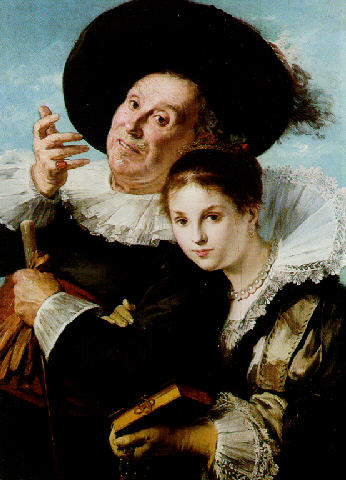
Another Marckelbach worthy of note is the Belgian painter Alexandre Markelbach (1824–1906). The work shown here is The Guardian, oil on panel, 93 x 68 cm. Completed in 1874. One may observe a resemblance of this painter's social views with that of his contemporary, the far more famous Edgar Degas (1834–1917).* (Source.) 12 This project includes numerous hyperlinks to the world-wide web; however, sites may change or disappear altogether.* That is why I am also in the process of making extracts from the sites referred to, a tedious job that slows down the work on this project. Our story's chapters include bibliographies of my background reading which, although not altogether haphazard, is far from thorough. That leaves plenty of room for improvement. 13A When starting out our story with the first Merckelbachs, I ran into a number of conundrums right off the bat. What are the motivations underlying the actions about which we have some small records? What are the responsibilities attached to the functions many Merckelbachs were mandated to exercise? How do we translate words like Schultheiß, Mannkammer? What would be the proper English word for the Dutch word Hof as in "Bovenste Hof van Merkelbeek"? What, precisely, are the differences between a count, a duke. a marquis, and a lord? And how did their roles change as time went by? Translations aside, what was originally meant by the words hoeve and hof? What, in fact, would be the proper words in today's Dutch or German or English to describe what was understood to be a hof and a hoeve in the 14th century? Do these words still mean the same? Would an appropriate English equivalent be "farmstead"? Or "court"? Or "manor"? Some help is found in an on-line etymology of Germanic languages and/or in our Minipedia. Nevertheless, experience is beginning to show it may be best to leave many words for functions and institutions untranslated and try to describe their meaning instead. And also how meanings change over time, and differ from place to place. 14 Achieving factual accuracy and proper balance are a serious problems. In the first chapter we surmised that the date of a wedding, recorded as 2-2-1321, should most likely be read as 2-2-1371. But how well is a surmise of this sort justified? Another example: We gave 1371 as the year the Battle of Baesweiler took place, but many other sources give 1372 as the year. (Seventy-one it is.) Was is it really Johann van Amstenrade Jr. who went to battle at Baesweiler, as I read in Rudolf Merkelbach's book, or was it his father, as written by family researcher Max Dechamps?* As for internet sources, how readily are errors parotted and multiplied with electronic speed! And so it goes. 15 Here another question to give some thought to. Is the name Merckelbach unique to one single, solitary family? The Merkelbeek estate probably has been in the care of earlier vassals of who some mavy have retained a the same or similar family name. I doubt it, but it is possible. And might the name of a hamlet in Germany's Westerwaldkreis have spawned essentially the same name? Consequently, is this writing about a single clan or also about people belonging to other clans with the same name? Should this matter? And, if so, in what way? That is the subject of Chapter 5, Are we alone? 16 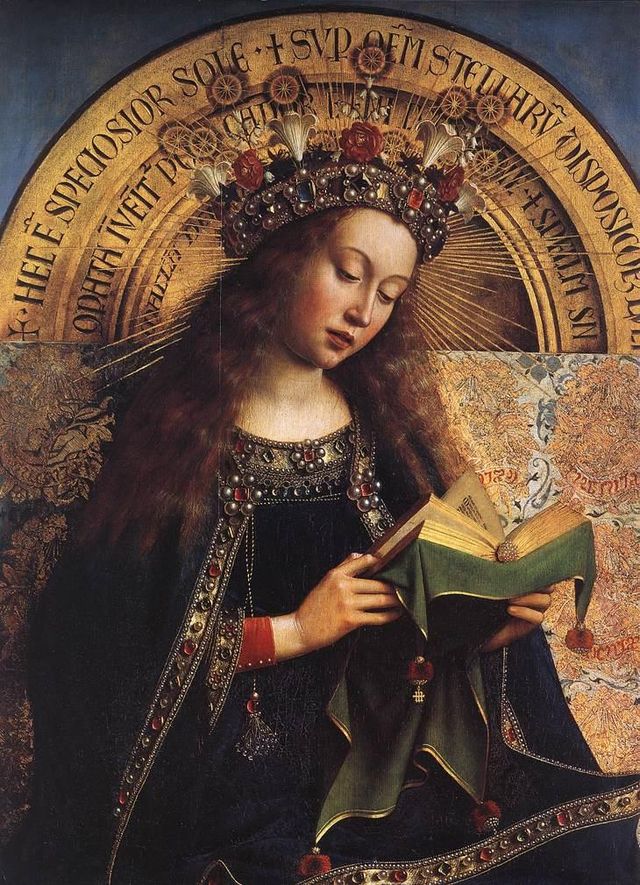
Detail of an altarpiece in the Saint Bavo Cathedral, Ghent. Created ~1432 by the Flemish painter Jan van Eijck. His brother Hubert may have had a hand in it as wel. Born in Maaseik, not far from Maastricht, there is considerable evidence that they were related to the Van Anstenrade/Merckelbach family as shown in Chapter 23. See footnote * for the entire piece. (Source.) 17A An institution of profound impact on medieval life was the Church. Years after I began this project, I came to feel that religion and the underpinning mythologies had a huge effect on the mental outlook of the Merckelbachs and their forefathers. A social history cannot ignore these influences and so you will find that we are going back, well, as far as the art found in the caves of Lascaux! Before that, even–not the kind of subject matter one expects to find in a simple family history. 17 Because of their importance, Christianity and the Church are major preoccupations of mine in developing this project. I must be careful to not entangle my personal beliefs with those held by individual Merckelbachs among who we find Roman Catholics, Protestants of various stripe, agnostics, maybe Unitarians, and probably atheists as well. In fact, we have a Merkelbach on record who converted to Islam. As for my personal sense of being human and the wonders of creation, I am trying to keep that out of this story, instead I am getting into this in the part of this website named My 2 cents. A reader has a right to know where an author comes from.* 17A 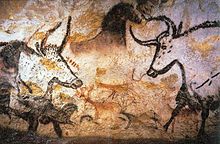
This painting, one of many, found in the caves of Lascaux, France, is about 15,000 years old. Various theories exist about the why and how they were created. One thought is that they are manuals for hunting like myths and the Bible may be viewed as manuals for correct behavior. More about this fascinating subject in Wikipedia and in our Minipedia. (Source.) 18 Inserted in our story are background sketches, mostly obtained from the Wikipedia and collected under headings such as Temper of the times, Timeline, and so forth. Temper of the times attempts to tell what our forefathers might have read about had only they been able to read newspapers and magazines as we know them today, with local and international news and sections for business and entertainment. For these I sometimes picked years of record in the family history; this means that they do not form a disciplined chronicle of events; merely snippets such as a traveller might pick up in some distant locale and thereby tune in to his novel surroundings. Thus we shall have some glances at, for example, the impacts of religion and, say, the fate of European Jews and who authorized slavery. In the 17th century, the Merckelbach tree suddenly shows the presence of Jewish names. Is this something insignificant, some streak of fashion, or does this reflect a historical happening of note? Under Timeline one finds chronologically arranged information intended as historical reference material for whatever period a chapter is about. 19 It is well to be comfortable navigating this site. Let's begin by taking a look at the brown menu bar near the top of this page. There we see:
"Our Story" is printed in yellow which means that the page we are on is a chapter of Our Story. As for the other rubrics, we need to back up a little. 20 However much we like it to be otherwise, we do not have on hand a nice, clean, unbroken sequence of Merckelbachs running from Reinert Huyn Von Merckelbeich all the way up to Adriaan Märckelbach. When I began this project, I only had these sources of disjointed information: 21 • A book by Rudolf Merkelbach named De afstammelingen van Gregorius (Goris) Mer(c)kelbach 1645–1995, already mentioned here. With these givens I then divided the family tree into three distinct rubrics: Roots, Trunk, and Crown, but later modified that to Roots, Trunk, and Branches. With the help and documentation contributed by various people (see Acknowledgment) as well as the expanding amount of information, it became clear that other, related changes needed to be made as well. The early part of Kreutzwald's genealogy is found in Trunk, along with two diverging scenarios both of which derived from the manuscript by Max Dechamps. All three scenarios show stubs for branches with geographical names such as Voerendaal/Heerlen, Wittem, and so forth. Clicking on the name of a branch takes one there.* Presenting three scenarios together is probably a little confusing at first, but genealogy is, after all, not always a clear-cut matter. 23 Maybe the following three line diagrams make it a little easier to see the differences between the three scenarios and where the branches are connected. In all cases the name of the first Merckelbach of each branch is shown. 24 Some of those branches are branched even further. The page named Branches discusses both the sources of information and how reliable they are, which is mostly pretty to very reliable. Please, roam around a while to get the feel of things. You will find the various "tree formats" associated with databases and lists of alphabetically arranged first names. As for Twigs, here we have simply a collection of snippets of yet unconnected genealogical data from which I hope we can fashion viable additions to the overall structure of our family tree. 25 Maybe the three line diagrams below make it a little easier to see the differences between the three scenarios and where the branches are connected. In all cases the name of the first Merckelbach of each branch is shown. 26 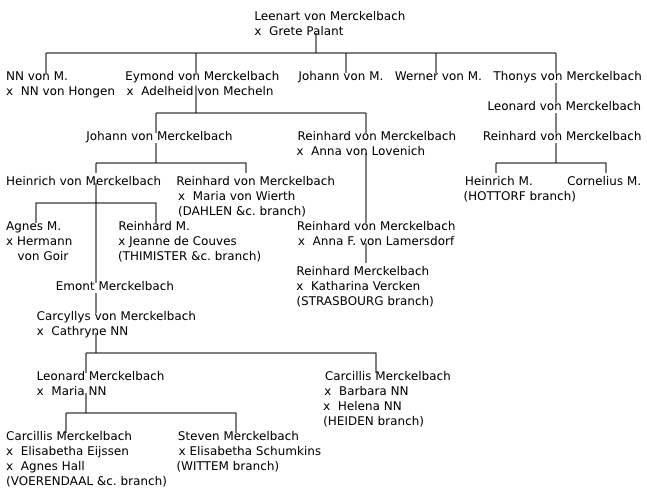 Scenario 1. Based on Tableau VIIIf of Dechamps' manuscript where Heinrich von Merckelbach is shown as the grandson of Emond von Merckelbach. This and the following scenarios have been modified by including Carcyllys von Merckelbach, a topic discussed in the next chapter, Bones of contention. 27 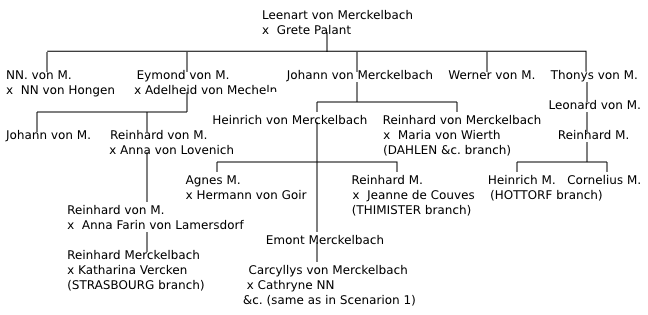 Scenario 2. Based on Tableau VIIIg of Dechamps' manuscript where Heinrich von Merckelbach is shown as the nephew of Emond von Merckelbach instead of his grandson. Modified by including Carcyllys Von Merckelbach. It should be borne in mind that Dechamps' MS is merely an unpublished set of notes that somehow became available to people interested in the Merckelbach ancestry. 28 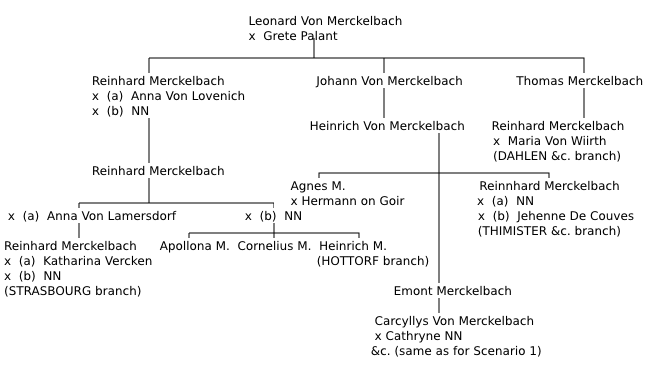 Scenario 3, an altogether different scenario. It is based on Kreutzwald's "Ahnenforschung" database, but modified by including Carcyllys Von Merckelbach. 29 Ahead of these three scenarios, Trunk actually contains a few scenarios about relationships between earlier Merckelbachs than found in Kreutzwald's work. 30 The ancestry of the first Merckelbach is found in the rubric Roots. Their genealogy has been culled from sites by Charles Cawley and Ger de Vries as mentioned in Chapter 1. Even though scepticism is a good trait for genealogists, the work of these two researchers is nothing short of highly impressive. 31 Next, let's turn our attention to the second line of of this page's top menu:
The Minipedia hasn't got quite off the ground yet. Part of it is intended to become a translation dictionary for unfamiliar terms, other parts make for a collection of short articles that serve to introduce important topics that pertain to Our Story. Documents is the home of reference material. Finally, the Directory is an alphabetical listing by first names of all the Merckelbachs found in the Trunk and its many branches and subsidiary branches. It does not seem necessary to include in this directory the names found in Roots. 33 Before leaving this chapter, a few words about those funny purple numbers seen at the end of, e.g. each paragraph. Traditionally, since their introduction in the early sixties by computer pioneer Doug Engelbart, these numbers permitted to direct the hyperlinking to parts of a collection of electronic documents with a text editor especially designed for the continuing manipulation of documents among people of different kinds of expertise cooperating on a project. The editor was known as Augment because it was designed to augment the human intellect by concentrating diverse brain powers on a particular project. These purple numbers can be copied into other documents in Augment by a mouse click. Left-clicking on such a number in this page raises the corresponding paragraph—or graphic or table or whatever—to the top of the screen. Try it, but bear in mind that what you see happening is merely a minor part of the purpose for which they were intended, ref. This quite aside from today's browsers choice of actions shown by right-clicking any hyperlink. 34 In this document I have also introduced compound ID numbers for identifying individuals. They look something like this: t.1.2a.1.2b. My original intention was for the first digit to identify the progenitor of a genealogical sequence, which then was Trunk, hence the leading t. The second number was to identify his second child where (a) indicates a first partner. The third number was intended to refer to the first listed child of person 1.2a., and the fourth would point to the second member of the subsequent generation, one who was the child by a second (b) partner.* It is because they are personal ID numbers that they ought to remain attached to the same person no matter what changes we are compelled to make. However, this scheme got corrupted with the influx of corrections and alterations in our representation of the family tree. I am looking forward to get things back on track again. That is the short of it. 34A This project was originally intended for my own family's use, a keepsake for my offspring. It was placed on a small, private section made available by my internet provider. It permitted me to show it to friends and to people able and willing to help improve it. It served me well, until ... until I began to receive emails from total strangers and thereby learned that Google had permitted free access to it by anybody surfing the net. This, of course made it, to my mind, necessary to improve reliability, to properly identify sources and indicate which data are at least reasonably trustworthy and which are not. At the same time there appeared to exist a desire for me to broaden the scope of the tree and thereby, I should hope, some influx of good information about relationships among those with the name Merckelbach and such variations, Merkelbach, Märckelbach, Merckelbagh, etc., etc. In the process, that "private" section became too small and I am now renting a more spatious server space. Here is hoping that with the efforts of other family researchers we shall discover some links currently missing, the major topic of the next chapter. 35 In conclusion, please bear in mind that not only the family tree, but also Our Story are works in progress, not likely to be finished any time soon. Chapters will be written as background information is gathered and studied, as time and health permit, and as the mood strikes me. 36 And one more thing: Our Story aims to be Your Story too! 36A Bibliography
|
|
According to Edgar Edgar Polomé, "Indo-European society, as far as we can judge, was agnatic and ethnocentric, its basic unit being the patriarchal, patrilinear, and essentially patrilocal extended family. Kindred was the foundation of its concentric structure, grouping the families in clans, claiming descent from a common ancestor, and the clans in tribes, presumably deriving their origin from some founder" (quoted by Russell.) * fn1 An example of cross-linking in history: This famous painting, as does Markelbach's The Guardian, portrays dominance of the male as symbolized by the phallic symbol the ballet master leans on. Spinsters, unless supported by reasonably well-to-do families or moving into a convent, had but few choices, among them becoming a ballerina. The pay was next to nothing, but a patron with deep pockets might put them up in an appartment for intimate têtes-à-tête. * fn2 While on this project, I happened to come across some beautiful examples of fleshed-out family trees. I was struck by one made by a Jan de Kuijper. It was enhanced with a story about the deeds of a nobleman who served with Floris V, a Dutch count. I am partial to Floris V because I believe that one of my ancestors was his messenger boy at a critical historical event that happened in 1296. The website has changed since the time I first referred to it. But the story, written in Dutch, has been recovered using the Wayback Machine and can be found here. * fn3 Maybe both because a 1385 record states that Johann de Jonge was a shield-bearer for his father. Going by the comparatively low ransom commanded for the release of the surviving Johann, or Jan, van Amsterode after the Battle of Baesweiler, one may suspect that this concerned Junior. This event will come up later in this history. * fn4 I began this project by simply following in Kreutzwald's footsteps, but it became apparent that keeping trunk and branches together in a single tree layout became just too unwieldy. The trunk as it was is shown here. * fn5 The numbering system originally used here was close to one known as the D'Aboville System, the main difference being the use of letters to distinguish between first, second, etc. marriages. I am contemplating to reintroduce the "pure" system. * fn6 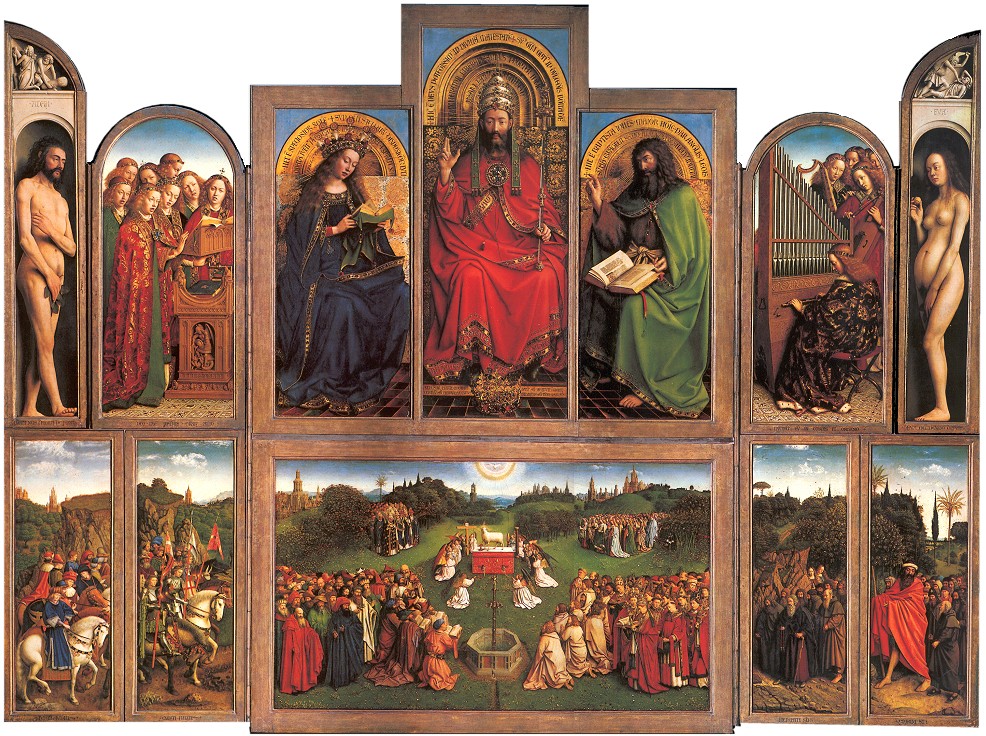 The piece is composed of twelve panels, eight of which are hinged shutters. The wings are painted on both sides, giving two distinct views depending on whether they are open or closed. Outside of Sundays and festive holidays, the outer wings were closed and often covered with cloth. It was commissioned from Hubert van Eyck, about whom little is known. He was most likely responsible for the overall design, but died in 1426. * fn7 |
--
| top of page |
|
Page maintenance:
Page format: Nov. 22, 2011
Story edit: Nov. 25, 2011
Spell check: Nov. 29, 2011
To be checked for timeliness:
¶ none
Reminders:
¶ none
Link check: Nov. 25, 2011
XHTML verify: Nov. 25, 2011
Backups: Nov. 17, 2011

credit: www.infovisual.info
Example of a patrilinear ancestry:
1 This is the genealogy[a] of Jesus the Messiah[b] the son of David, the son of Abraham:
2 Abraham was the father of Isaac,
Isaac the father of Jacob,
Jacob the father of Judah and his brothers,
3 Judah the father of Perez and Zerah, whose mother was Tamar,
Perez the father of Hezron,
Hezron the father of Ram,
4 Ram the father of Amminadab,
Amminadab the father of Nahshon,
Nahshon the father of Salmon,
5 Salmon the father of Boaz, whose mother was Rahab,
Boaz the father of Obed, whose mother was Ruth,
Obed the father of Jesse,
6 and Jesse the father of King David.
David was the father of Solomon, whose mother had been Uriah’s wife,
7 Solomon the father of Rehoboam,
Rehoboam the father of Abijah,
Abijah the father of Asa,
8 Asa the father of Jehoshaphat,
Jehoshaphat the father of Jehoram,
Jehoram the father of Uzziah,
9 Uzziah the father of Jotham,
Jotham the father of Ahaz,
Ahaz the father of Hezekiah,
10 Hezekiah the father of Manasseh,
Manasseh the father of Amon,
Amon the father of Josiah,
11 and Josiah the father of Jeconiah[c] and his brothers at the time of the exile to Babylon.
12 After the exile to Babylon:
Jeconiah was the father of Shealtiel,
Shealtiel the father of Zerubbabel,
13 Zerubbabel the father of Abihud,
Abihud the father of Eliakim,
Eliakim the father of Azor,
14 Azor the father of Zadok,
Zadok the father of Akim,
Akim the father of Elihud,
15 Elihud the father of Eleazar,
Eleazar the father of Matthan,
Matthan the father of Jacob,
16 and Jacob the father of Joseph, the husband of Mary, and Mary was the mother of Jesus who is called the Messiah.
17 Thus there were fourteen generations in all from Abraham to David, fourteen from David to the exile to Babylon, and fourteen from the exile to the Messiah.
--Matthew 1 - 17: The Genealogy of Jesus the Messiah. (THE HOLY BIBLE, NEW INTERNATIONAL VERSION®, NIV® Copyright © 1973, 1978, 1984, 2011 by Biblica, Inc.™ Used by permission. All rights reserved worldwide.)
Following in Matthew's footsteps, Adriaan Märckelbach's ancestry would go something like this:
1 This is the genealogy of Adriaan Märckelbach the son of Johann Heinrich Merckelbach, the son of Reynhart Huyn van Merckelbach, the son of Count Adalbert I Van Ballenstedt:
2 Adelbert was the father of Esiko and his brothers,
Esiko was the father of Adelbert and his brothers,
Adelbert was the father of Siegfried and his brothers whose mother was Richesca van Richterich,
3 Siegfried was the father of Meiner Anserdal who lived on Kerkrade and became known as Meiner van Anstel,
Meiner was the father of Arnold,
Arnold was the father of Godefridus,
4. Godefridus was the father of Godefridus II,
Godefridus II was the father of Nicolaus,
Nicolaus was the father of Wilhelm van Anstel,
5. Wilhelm was the father of Henricus Servaes van Anstel, named Hunne,
Henricus Servaes was the father of Reynert who took the name Huyne von Merkelbeich
and thereby became the first Merckelbach and with whom our story really takes off.
6. Reynert was the father of Reinier Huyn van Merkelbeek by one telling,
Reinier was the father of Heynrich Huyn von Merckelbach,
Heynrich was the father of Leenart who took as wife Grete, illegitimate child from the House of Von Palant,
7. Leenert was the father of Johann von Merckelbach and his brothers,
Johann was the father of Reynhart von Merckelbach, a learned man,
Reynhart was the father of Dr. Thomas Merckelbach and his brothers,
8. Thomas was a priest who began to preach the protestant variant of Christian worship, married, and begat eleven children.
Among the children was Peter, the father of Johann Georg,
Johann Georg was the father of Johann Wilhelm,
9. Johann Wilhelm, by one telling, became the father of another Johann Wilhelm,
This Johann Wilhelm is said to be the father of Peter,
Peter is thought to be the father of Johannes Heinrich Merckelbach who joined Regiment Orange-Nassau II,
and wherever his Regiment went, his wife Klazina usually bore him another child or two.
10. Johannes Heinrich, whom we dubbed "our Soldier of Orange," was the father of Johan George and his brothers,
Johan George was the father of Johannes Hendricus Marckelbach whose mother was Gerarda Catharina Borgstern,
Johannes Hendricus was the father of Jan George Märckelbach with an Umlaut,
11. Jan George was the father of Gijsbert Matthijs whose mother was Pouline Caroline Bagman,
Gijsbert Matthijs was the father of Adriaan Märckelbach whose family name is written on official records Märchelbach and who had three daughters,
Elisabeth Hendrika, Catharina Willemien and Adriana.
Elisabeth Hendrika has a son given the name Marc, the first letters of Marckelbach.

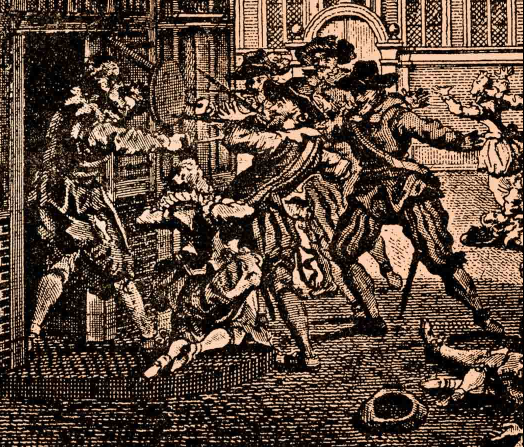
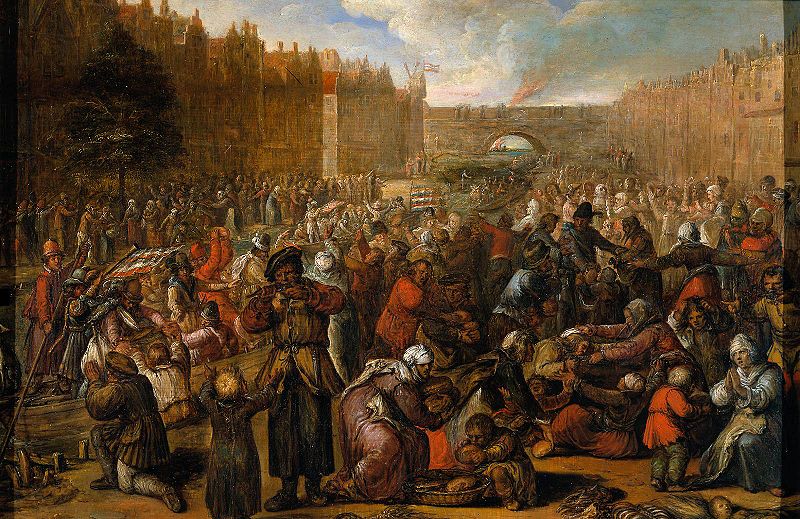
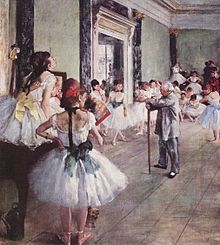 Edgar Degas, The Dance Class, painted over the period 1873–1876. (
Edgar Degas, The Dance Class, painted over the period 1873–1876. (